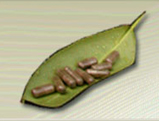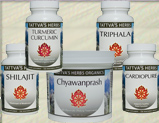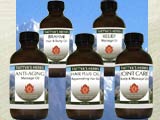 Loading... Please wait...
Loading... Please wait...Turmeric: “The Golden Goddess”
Posted by Lisa Gallant C.A.S., California College of Ayurveda on 19th Oct 2011
Introduction
Within the cornucopia of medicinal plants, few possess such a wide spectrum of qualities and medicinal uses as turmeric. For countless centuries, many different cultures have used this wonderful, versatile herb to treat a myriad of diseases and ailments. The most well known medicinal action of turmeric is its use as a powerful anti-inflammatory, the effectiveness of which is comparable to pharmaceutical medicines. However, it also acts as an alterative, analgesic, antibacterial, anti-inflammatory, anti-tumor, anti-allergic, anti-oxidant, antiseptic, antispasmodic, astringent, carminative, cholagogue, digestive, diuretic, stimulant, and vulnerary 6,8,10 . Modern science is beginning to recognize and understand the amazing healing qualities of turmeric and much research is currently being conducted.
Turmeric has been proven effective in treating some of the most intense ailments afflicting the world today including: Arthritis, Cancer, Alzheimer’s Disease, Diabetes, Multiple Sclerosis, Atherosclerosis, HIV/AIDS, Sexually Transmitted Diseases (Hepatitis-C, Genital Herpes) , Irritable Bowel Syndrome, Indigestion, Inflammation, Acne, Urinary Tract Infections, Kidney Infections, Gallstones, Anemia, Hemorrhoids, Liver Disease, Leprosy, Amenorrhea, Edema, Bronchitis, Common Cold, Headaches, Conjunctivitis, Bursitis, food poisoning, parasites, fever, diarrhea, poor circulation, lower back and abdominal pain. It can also be used as a mosquito repellent, wound healer, and immediate cure for scorpion stings. Turmeric helps balance the female reproductive and lactation systems, and in men it purifies and improves the health of semen. It is used to treat external ulcers that would not respond to other treatment 6,8,10 . Due to its vast array of medicinal purposes and versatility, turmeric is one of the most important herbs in any natural medicine cabinet.
The Latin name for turmeric is “Curcuma Longa”, which comes from the Arabic name for the plant, “Kurkum.” 10 It comes from the Zingiberaceae family (same as ginger) and in Sanskrit is called “Haridra”(“The Yellow One”), “Gauri” (“The One Whose Face is Light and Shining”),“Kanchani” (“Golden Goddess”) , and Aushadhi (“Herb”). It is called “Jiang Huang” in Chinese, and “Haldi” (“Yellow”) in Hindi, the most common name in India 6 . The healing properties of turmeric lie in the golden fingerlike stalk, or rhizome, the same part that is used to flavor, color, and preserve food. Turmeric is commonly found in Indian curries, giving the food a golden orange color. Turmeric has also been used as a dye for mustards, canned chicken broth, and pickles. It has been coded as food additive “E100” in canned beverages, baked products, dairy, ice cream, yogurts, yellow cakes, biscuits, popcorn, sweets, cake icing, cereal, sauces, gelatins, and also direct compression tablets. In combination with annatto, turmeric is used to color cheese, dry mixes, salad dressing, butter and margarine 3 . The brilliant color has also been used for dyeing silk and wool; the robes of Buddhist monks were traditionally dyed with turmeric 10 .
Turmeric is a native to South Asia , particularly India , but is cultivated in many warm regions of the world. It can be found growing extensively in all of India , but does especially well in the regions of Tamil Nadu, West Bengal , and Maharashtra 10 . It is also cultivated in Sri Lanka , Indonesia , China , Taiwan , Indochina , Peru , Haiti , and Jamacia. India is the largest producer in the world; Jamacia and Peru are the chief exporters, and Iran the largest importer. Other large importers are the United Kingdom , Japan , Canada , Sri Lanka , Singapore , and the Middle East 9 .
There are two main varieties of turmeric: one with hard, rich colored, oval rhizomes, called “Lokahandi Halad” that is used mostly for dying, and a variety that is softer, larger, lighter colored with long rhizomes used mostly for eating 8 . Turmeric became valuable to humans when it was discovered that the powdered rhizome preserved the freshness and nutritive value of foods. It was originally used in curries and other food to improve storage conditions, palatability, and preservation. Because of its preservation properties, turmeric played a vital role in survival and sustainability in South Asia , and was valued more than gold and precious stones 7 . However, turmeric was eventually replaced by cheaper, synthetic preservatives.
Turmeric was used much more extensively by the natives of India than today. Turmeric was highly valued by the ancient Indo-European people not only for its preservation properties, but for its energetic and spiritual qualities as well. The Arya culture was a group of people who worshipped the solar system and the sun as a deity. Turmeric was very sacred to them, due to its golden yellow color (like sunlight) and they believed it had special protective properties 7 . Remnants of this belief still exist today, particularly in South India , where some people wear a dried turmeric rhizome bead the size of a large grape around their neck or arm. This is an ancient talisman tradition used to ward off evil and grant to the wearer healing and protection 16 . People of ancient India believed that turmeric contained the energy of the Divine Mother, helped to grant prosperity, cleanse the chakras (energy centers in the body), and purify the channels of the subtle body 6 . Even today, Hindu people consider turmeric to have auspicious qualities, and use it in many sacred ceremonies. It is commonly made into a paste and applied to the forehead (ajna chakra or third eye) during pujas (devotional ceremonies) and weddings. During a traditional Indian wedding ceremony, the bridge and groom apply a paste of turmeric and sandalwood powder on each other’s foreheads. Some women use it as a cosmetic, called “Kappumanjal” or rub it over their bodies as a detergent 8 . Traditionally, turmeric was also used to dye the marriage clothing. It was believed that any clothing dyed with turmeric was protection from fever. New clothes would sometimes be stained with a paste of turmeric, lime, and water. Today, magenta dye has become more popular 9 .
Turmeric and Ayurvedai
Turmeric has been used for centuries in Ayurveda, the 5,000 year old natural healing system of India . It is called by 46 different synonyms, including: “pitta” (yellow), “gauri” (brilliant), and all words that indicate “night” 10 . This comes from a tradition of married women applying turmeric to their cheeks in the evening in preparation for a visit from Lakshmi (The Goddess of Prosperity) 7 . In Ayurveda, turmeric is believed to balance the three doshas (vata, pitta, and kapha). It has been used by Ayurvedic healers as medicine taken internally in the form of fresh juice, boiled tea, tinctures, or powder, and topically as creams, lotions, pastes, and ointments 1 . There are many ancient Ayurvedic formulas utilizing turmeric. Milk boiled with turmeric and sugar was a popular cold remedy and turmeric juice was used to help heal wounds, bruises, and leech bites. A paste made from turmeric, lime, and salt was commonly applied to sprains and inflamed joints 8 . Smoke made by sprinkling turmeric over burnt charcoal was used to relieve scorpion stings within a few minutes that the affected area is exposed to smoke. Inhaling the fumes of burning turmeric was also used commonly to release copious amounts of mucous and provide instant relief from congestion. The fumes also were believed to help in hysteric fits 8 . A pinch of turmeric was also used as an insect repellent in the kitchen 9 . A paste made of turmeric alone or with neem leaves was used for ringworm, itching, eczema, and any other parasitic skin condition 8 . The Charakra Samhita section on Therapeutics states that turmeric, black pepper, long pepper, and ox bile was a common remedy for consumed poison or snake bites, up until the last stage 15 . The Charakra Samhita also provides a traditional remedy for jaundice: turmeric, triphala, neem bark, bala, licorice cooked in milk and ghee of buffalo. If this did not work and there is “found residue of morbidity still lodged in the body”, inhalation therapy was indicated. Cigars were made from turmeric paste, cinnamon, castor plant root, lac, red arsenic, deodar, yellow orpiment, and nardus, smeared with ghee and smoked. Inhalation of the fumes of barley paste with ghee was also a treatment for jaundice 15 . Hemorrhoids (piles) were treated with an ointment of turmeric, hemp leaves, onions, and warm mustard oil or linseed oil, applied externally when the hemorrhoids are painful and protruding 8 . Pastes of turmeric were used for smallpox, chickenpox, shingles, ulcers, conjunctivitis, skin blemishes, malaria, and applied to the cut placenta after the birth of a child 8 .
Turmeric has hundreds of molecular constituents, each with a variety of biological activities. There are at least 20 molecules that are anti-biotic, 14 that are known cancer preventatives, 12 that are anti-tumor, 12 are anti-inflammatory and there are at least 10 different anti-oxidants 7 . One database presented over 326 known biological activities of turmeric 12 . The rhizome is 70% carbohydrates, 7% protein, 4% minerals, and at least 4% essential oils. It also has vitamins, other alkaloids, and is about 1% resin 7 . The active ingredient in turmeric is called “curcumin”, although in its raw state turmeric only contains 2-5% curcumin 4 . Curcumin is the substance that is responsible for the biological activity of turmeric. Combined with black pepper, curcumin becomes 2000 times more potent 4 . Curcumin is now extracted from turmeric, sold as supplements, and is the basis of most scientific research.
The active properties of curcumin are best called “protective properties”. The same components that prevent deterioration of food protect living tissue from degenerating, possibly extending the life span of our bodies 7 . Clinical and laboratory research indicates that diets that include turmeric or curcumin “stabilize and protect biomolecules in the body at the molecular level”, which is shown in its anti-oxidant, anti- mutagenic, and anti-carcinogenic action 7 . These components may work by protecting a person directly, by shielding the biomolecules, or indirectly, by stimulating the natural detoxification and defense mechanisms of the body: helping the body to heal and preserve itself naturally 7 . Current statistics show that 98% of all diseases are controlled by a molecule called NF-Kappa B, a powerful protein that promotes abnormal inflammatory response in the body. Excess of NF-Kappa B can lead to Cancer, Arthritis, and a wide range of other diseases. Studies show that curcumin subdues NF-Kappa B, meaning that it may work to prevent nearly all diseases afflicting our world today 4 .
Science and Turmeric
Scientists are beginning to realize the importance of turmeric/curcumin in treating modern disease. Much research has been conducted on the various effects of curcumin in the body; the most widely researched is that of its effects on Cancer. In both India and Pakistan , where curry/turmeric is a dietary staple, boast much lower incidence of cancer than in other countries where turmeric is not regularly consumed 2 . Turmeric is considered to fight Cancer in three ways: It neutralizes those substances and conditions which can cause cancer; It directly helps a cell retain its integrity if threatened by carcinogens (a substance showing significant evidence of causing cancer or growth of cancer cells); If a tumor does grow the curcumins can often destroy it 13 . There are many reasons why turmeric helps to destroy Cancer. One of the keys to this activity is the ability of curcumin to inhibit the enzyme Topoisomerase, which is required for the replication of cancer cells. “Topoisomerase works within the nucleus of the cell, where it first binds to supercoiled DNA and then catalyzes the passage of one DNA helix through another via a transient double-stranded break. This splits the DNA and thus allows cell replication to occur. Stopping Topoisomerase stops replication which stops the spread of the problem 13 .”
Curcumin is also one of the most studied natural COX-2 inhibitors, which block an enzyme called cyclooxygenase-2. This is beneficial because the COX-2 enzyme helps make carcinogens more active in the body and allows cancerous cells to survive by growing new blood vessels 2 . In essence, curcumin completely blocks the formation of cancer causing enzymes, decreasing the likelihood of cancerous cell formation or growth. Curcumin is also rich in antioxidants, which are important disease fighting substances that help to clean up unstable oxygen molecules (free radicals) that can damage cells and cause diseases such as Cancer. Other antioxidants and COX-2 inhibitors are red grapes, green tea, rosemary, and bee propolis 2 .
Even when using more allopathic methods to treat cancer, turmeric/curcumin still helps to increase the effectiveness and decrease some of the side effects of cancer treatments. Current research suggests that including curcumin in the diet during the “initiation and or post initiation periods” of cancer significantly suppresses the development of chemically induced tumors 13 . In summary, research is showing that curcumin may be more effective treatment for cancer in the beginning phases of the disease, as well as preventative treatment throughout life before cancer even emerges. A study performed in 1992 on 16 cigarette smokers who took 1.5 g of turmeric a day for 30 days had much lower mutagenic levels in their urine than those who did not include turmeric in their diet 1 . Mutagens are substances that cause cell mutation and increase the occurrence of cancer. There is, however, some new research suggesting that taking curcumin may counteract the effectiveness of chemotherapy. Thus, many cancer treatment programs are developing a periodic schedule of use to avoid any issues 13 .
“We have not found a single cancer on which curcumin does not work”, states Dr. Bharat Aggarwal, who conducts cancer research at the Jawaharlal Nehru Centre for Advanced Scientific Research in Bangalore , India 4 . Ayurveda especially recommends turmeric for cancers of the female reproductive system, specifically breast and uterine cancer, and to treat benign tumors as well 11 . Although the current research looks promising, there have been very few long term tests performed on large quantities of humans. Turmeric was recently nominated by the National Cancer Institute for more study so we can look forward to many more research findings in the future.
Turmeric is also a powerful anti-inflammatory herb. It has been shown to be helpful in the treatment of Arthritis, Rheumatoid Arthritis, Osteoarthritis, injuries, trauma, and stiffness from both under activity and over activity 10 . It is also helpful after surgery to decrease pain, inflammation and accelerate healing. One study conducted in 1986 showed that a dosage of 1200 mg of curcumin a day was more effective in reducing post-surgical inflammation than either the placebo group or anti-inflammatory medication normally prescribed 5 . In India , turmeric is considered the standard anti-inflammatory, and yogis use it to help keep their tendons and ligaments free from injury and to assist in their asana practice 6 . In the same way, it minimizes pain and inflammation related to any kind of exercise or strenuous activity. Majeed states: “Perhaps Turmeric’s most important anti-inflammatory mechanism centers on its effects on the Prostaglandins (PGs), a large family of potent lipids produced by the body. PG1 and PG3 calm the body while PG2 inflames the body. Turmeric is a potent inhibitor of cyclooxygenase 5-lipoxygenase and also 5-HETE production in neutrophils. Reducing these enzymes means less arachidonic acid metabolism, which means less PG2, which means less pain and inflammation 7 .” Some sources suggest that turmeric/curcumin is most effective for acute inflammation, and not for chronic 1 . Many sources recommend turmeric for Arthritis but the scientific evidence is still unclear and much more research is underway.
Turmeric also has a special action to purify and nourish the blood and skin. External application stops pain and swelling, heals wounds rapidly, and treats many skin diseases ranging from acne to leprosy. The classic way to apply turmeric topically is as an “Ubtan”: a blend of turmeric, chick-pea flour, sesame or almond oil, a little fresh cream and honey. This will clear up skin blemishes, and increase the natural glow and radiance of the skin 16 . Turmeric essential oil works wonderfully as an external antibiotic to prevent infections in wounds. A nice formula for a wound healing salve is a mixture of olive oil, beeswax, tea tree oil, aloe, turmeric, arnica, slippery elm, red clover, thyme oil, and vitamin E 9 . Since turmeric is bitter and anti-inflammatory, it is excellent for hot skin diseases, red rashes, and especially wet eczema 16 . Turmeric essential oil, mixed with citronella, tulsi, and vanillin, works as a powerful insect repellent, and is a natural alternative to D.E.E.T, the most common chemical insect repellent commercially available. Studies show that D.E.E.T. is extremely toxic, hazardous to the environment, and actually kills plant and insect life that it contacts 3 .
Turmeric also protects the liver from toxins and pathogens. It is known to both destroy m toxins in the liver, and to rebuild the liver after a toxic attack 16 . Turmeric increases the secretion and movement of bile, and may prevent all forms of liver disease. Excessive use of drugs and/or alcohol can tax the liver and lead to liver diseases 16 . One study shows that curcumin blocks some of the harmful side effects of cigarette smoke, and prevents dangerous chemical formation after eating processed food 11 . It is also helpful in treating food poisoning. Traditionally, about 5 grams of Turmeric is taken with a glass of whey, morning and evening, for a month to activate and rebuild a liver 8 . Another good liver remedy could be based on Turmeric, Kutki root, and Milk Thistle seeds. In essence, turmeric helps keep the liver healthy so it can do its job of keeping the body detoxified.
Ayurveda uses turmeric to purify and move the blood, as it is a wonderful alterative. It helps to remove stagnant blood while stimulating the formation of new blood tissue 6 . Turmeric regulates menses, and decreases the intensity and pain of menstrual periods, and of uterine tumors. Turmeric is a mild and supportive uterine stimulant and its many actions on the liver suggest that it may assist in balancing hormone levels as well 16 .
Turmeric also plays a role in pregnancy and birthing in India . Traditionally, it is said that taking turmeric when pregnant will ensure that the child will always have beautiful skin 16 . (However, turmeric is a mild uterine stimulant, so there is a chance of over stimulation; it is essential to consult a healthcare practitioner before taking any herbs during pregnancy.) Turmeric taken in the last two weeks of pregnancy in warm, organic milk helps to expedite a simple birth, while increasing the health of the mother and child as well. Turmeric is also an analgesic (pain reliever) and is sometimes used in natural childbirth to decrease pain 16 .
Turmeric also has a special action to help the entire Gastro-Intestinal system by increasing intestinal flora and generate healthy digestion 6 . It is traditionally used for weak stomachs, poor digestion, dyspepsia, parasites, abdominal cramps, to normalize metabolism, to help digest protein and breakdown of fats, to increase absorption, and the ability of the stomach to withstand digestive acids 6 . Turmeric is also a carminative: it helps to decrease gas and distention. According to Ayurveda, plants that treat digestion are often the most important herbs of all since digestion is the basis of mental and physical health. Prashanti de Jager states, “Turmeric is one of the best carminatives because though it leans towards being heating-pungent, it is very balanced and does not aggravate any of the doshas if taken in normal amounts, a few grams per day 16 .” As a vulnerary it also helps to nurture and heal mucous membranes; it has a strong protective effect against food and materials that are corrosive to the stomach and intestines as from food poisoning. In a 1989 double blind study (the participants and researches did not know which groups were taking the herb or the placebo) conducted in Thailand , 500mg capsules of curcumin were given to 116 adults suffering from indigestion at six different hospitals. Stunning results showed that 90% of those taking the curcumin felt full or partial relief after seven days, while 53% of the placebo group felt relief 1 .
Another major use of turmeric is support of the respiratory system. As an anti-oxidant it protects the lungs from pollution and toxins. It also helps the oxygen transfer from the lungs to the blood. Turmeric with ghee is traditionally used to get rid of cough and to treat asthma 8 . It also supports the heart in many ways. A study conducted in 1992 shows that turmeric may assist in lowering cholesterol and prevent Atherosclerosis (blockage of arteries that can cause heart attack and/or stroke) 12 . Animal studies have shown that turmeric lowers cholesterol levels and inhibits the oxidation of LDL (“bad cholesterol”, responsible for clogging of arteries). When LDL becomes oxidized, it creates deposits in the walls of blood vessels and contributes to the formation of arteriosclerosis. Turmeric may also prevent platelet buildup along the walls of injured blood vessels, another common cause of blood clots and artery blockage that can result in heart attacks and strokes 12 .
Studies are also underway regarding turmeric’s believed effects in treating and preventing neurological diseases such as Multiple Sclerosis and Alzheimer’s Disease. This belief generates from the realization that elderly Indian people who eat turmeric on a regular basis are far less likely to develop these ailments than those who do not eat turmeric. In fact, Alzheimer’s Disease is 4.4 times less common among older adults in India than in the United States 4 . It has been noted that people taking anti-inflammatory medication for Arthritis are less likely to develop Alzheimer’s Disease 1 . Since turmeric possesses such a powerful anti-inflammatory action, scientists speculate that it most likely will have a preventative effect on such disorders. More research is needed in this area to prove such theories.
New research also suggests that turmeric may play a vital role in fighting HIV/AIDS, particularly HIV, Type 1 10 . In a recent study at the Jawaharlal Nehru Centre for Advanced Scientific Research in Bangalore , India , when scientists ‘fed’ curcumin to HIV-infected cells in the laboratory, the virus stopped replicating 17 . Several studies have shown that people who have HIV and AIDS are deficient in many antioxidant vitamins and minerals, and it is believed that it is the powerful antioxidant properties of turmeric that combat the disease 17 . “Curcumin’s antioxidant properties will protect your DNA from the ravages of the virus. It’s also antimicrobial, so it will help prevent the many opportunistic illnesses associated with HIV and AIDS,” says Dr. Susan Kowalsky, N.D., a naturopathic doctor in Norwich , Vermont 18 . In a study at Harvard Medical School , research showed that curcumin prevented the reproduction of HIV by blocking a specific gene that activates the virus and causes it to spread. Another study showed that it may help decrease the reproduction of HIV 18 . This is a currently major topic of research, so we can look forward to updates in the near future.
Turmeric can obviously stand the test of time. It has been worshipped, reveled and revered by people for centuries, and still today it is one of the most significant players in the prevention of serious disease as well as the general afflictions of living. Much more research is underway to prove scientifically what the ancient people of India have known for centuries: that turmeric is one of the most powerful plants on the planet. Whether suffering from an acute or chronic disease, aches and pains, bumps and bruises, or as preventative maintenance, turmeric can and should be utilized by everyone on a regular basis. In the words of David Frawley: “If I had only a single herb to depend upon for all possible health and dietary needs, I would without much hesitation choose the Indian spice turmeric 16 .” Without a doubt, this writer feels exactly the same.
References
1. Whole Health MD.com , Article: “Turmeric”.
http://www.wholehealthmd.com/refshelf/substances_view/1,1525,10062,00.html
2. Whole Health MD.com , Article: “Cancer Fighters in Your Spice Rack,” 3/21/2001 .
http://www.wholehealthmd.com/news/viewarticle/1,1513,844,00.html
3. The Wikipedia Encyclopeida
http://en.wikipedia.org/wiki/Turmeric
4. Sundaram, Viji. Article: “Don’t Go Easy on Turmeric: It Prevents and Cures Cancer”: India-West , 2005
5. HealthNotes , Article: “Turmeric”, 2002.
http://www.drugstore.com/templates/hnotes/default.asp?catid=41779&aid=33…
6. Frawley, David & Vasant Lad, The Yoga of Herbs . Lotus Light Publications, 1993.
7. Majeed, Muhammed; Vladimir Badmaev; Uma Shivakumar; R.Rajendran, eds., Curcuminoids ; antioxidant phytonutrients. NutriScience Publishers, Inc, 1995.
8. Nadkarni, K.M., The Indian Materia Medica. Bombay Popular Prakashan, 1976.
9. Kaushik, Purshotam, Haridra (Turmeric): Antibacterial Potential . Chowkhamba Sanskrit Series Office, Varanasi , 2003.
10. Williamson, Elizabeth , ed., Major Herbs of Ayurveda. Churchill Livingstone, 2002.
11. Pook, Sally, “ Curries May Help to Combat Cancer”. Article: news.telegraph.co.uk
12. University of Maryland Medical Center , Article: “Turmeric”.
http://www.umm.edu/altmed/ConsHerbs/Turmericch.html
13. Cancer Research , Article: “Chemopreventive Effect of Curcumin , a Naturally Occurring Anti-Inflammatory Agent, during the Promotion/Progression Stages of Colon Cancer ” Cancer Research 59, 597-601, February 1, 1999 .
14. Cole GM , Lim GP , Yang F , Teter B , Begum A , Ma Q , Harris-White ME , Frautschy SA . “Prevention of Alzheimer’s disease: Omega-3 fatty acid and phenolic anti-oxidant interventions.” Neurobiol Aging. October 30, 2005 .
15. Dash, Bhagwan and R.K. Sharma, Caraka Samhita . Chowkhamba Sanskrit Series Office, Varanasi ,India , 2001.
16. Prashanti de Jager, Article: “Turmeric: The Ayurvedic Spice of Life”, 2003.
17. SciDev.net , Article: “Turmeric can Combat malaria, Cancer Virus, and HIV”. March 6, 2006 .
http://www.scidev.net/news/index.cfm?fuseaction=printarticle&itemid=1987…
18. Mother Nature.com, Article: “HIV and AIDS”.http://www.mothernature.com/Library/Bookshelf/Books/23/102.cfm
19. Pub-Med, Article: “In Vitro and in Vivo Anti-Tumoral Effect of Curcumin Against Melanoma Cells.” http://www.ncbi.nlm.nih.gov/entrez/query.fcgi?cmd=Retrieve&db=pubmed&dop…















